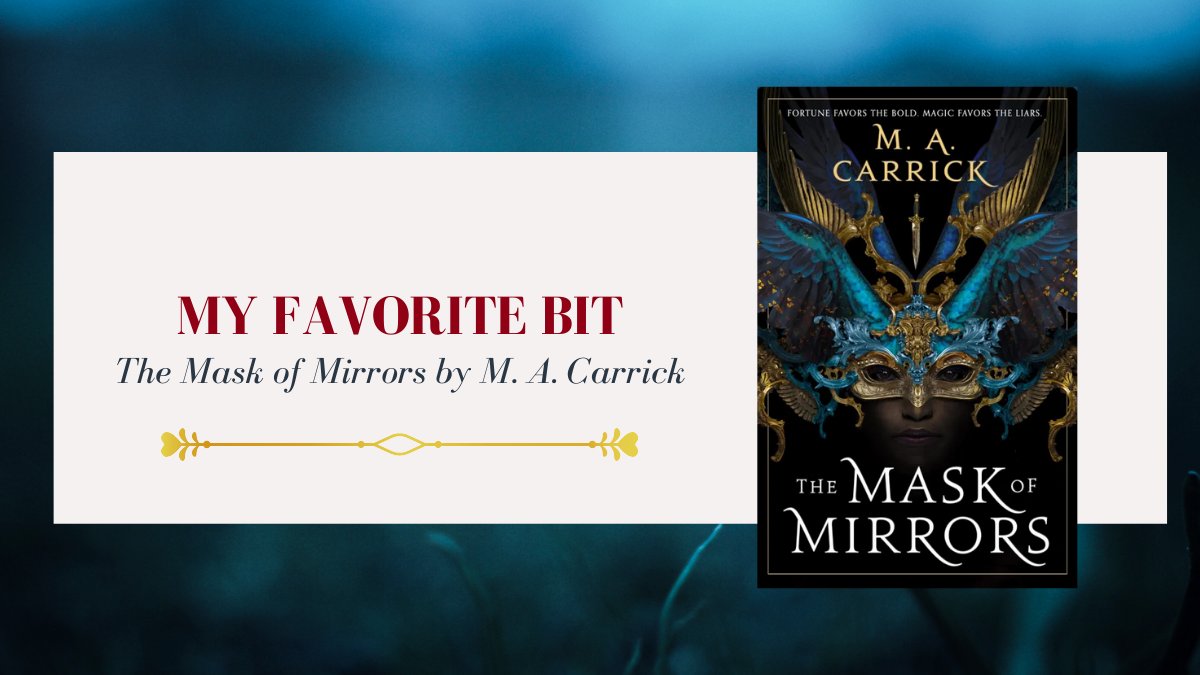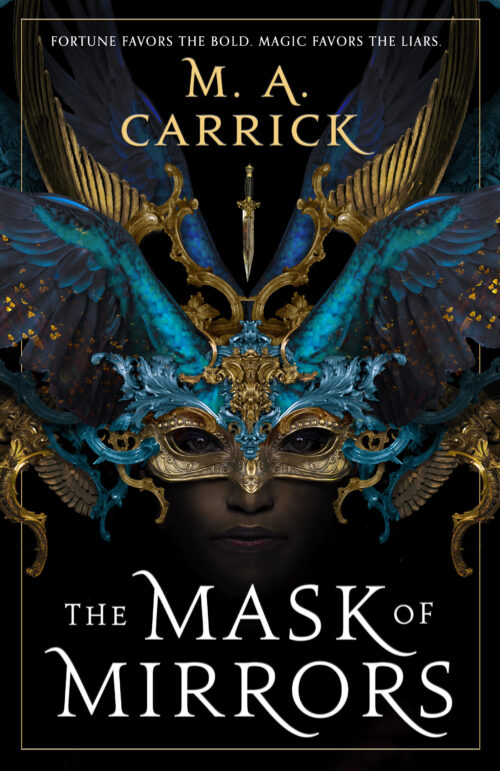
Marie Brennan and Alyc Helms, writing together as M.A. Carrick, are joining us today to talk about their novel, The Mask of Mirrors. Here’s the publisher’s description:
The Mask of Mirrors is the unmissable start to the Rook & Rose trilogy, a darkly magical fantasy adventure in which a con artist returns to the city that betrayed her, determined to have her revenge—only to find that her fate might be to save it.
This is your past, the good and the ill of it, and that which is neither . . .
Arenza Lenskaya is a liar and a thief, a pattern-reader and a daughter of no clan. Raised in the slums of Nadezra, she fled that world to save her sister.This is your present, the good and the ill of it, and that which is neither . . .
Renata Viraudax is a con artist recently arrived in Nadezra. She has one goal: to trick her way into a noble house and secure her fortune.This is your future, the good and the ill of it, and that which is neither . . .
As corrupt nightmare magic begins to weave its way through the city of dreams, the poisonous feuds of its aristocrats and the shadowy dangers of its impoverished underbelly become tangled—with Ren at their heart. And if she cannot sort the truth from the lies, it will mean the destruction of all her worlds.
What’s M.A. Carrick’s favorite bit?

M.A. CARRICK
If we’re being honest, The Mask of Mirrors is kind of wall-to-wall favorite bits. Step One in our collaboration was making a list of tropes we each liked, and while not all of them show up in this series (no mermaids, for example), quite a lot of them get worked in somewhere: swords, dancing, courtly intrigue, masks, sibling or sibling-type relationships, layered identities, queerness, tea, and so forth.
And clothes.
Not just on the level of “the characters are not walking around naked,” but clothing as both a sensory indulgence and a meaningful component of the story. Our protagonist Ren is a con artist, passing herself off as a foreign noblewoman; part of how she establishes herself as a desirable part of Nadežran society is through her elegant clothing. But this isn’t just window dressing, because she’s running her con on a shoestring budget — and so her sister Tess, seamstress extraordinaire, has to rework items to make it seem like Ren’s wardrobe is three times its actual size, and make use of scraps such that nothing goes to waste. For them, clothing is both a tool and a source of danger, if anybody notices what’s actually going on.
There’s a cultural dimension, too. Nadežra is a colonized city, split between the local Vraszenian populace and their Liganti overlords, so naturally we wanted to show that divide in how people dress, as well as other aspects of their lives. That meant an early component of our worldbuilding involved figuring out silhouettes for both societies, as well as places where they’ve begun to overlap and blend. The first book of this trilogy gives us relatively few opportunities to show off sumptuous Vraszenian clothing, compared to the Liganti version, but it’s there — they do amazing embroidery and lace (because Vraszenian culture overall is Textile Motifs Ahoy, but that’s a separate essay).
Even magic gets involved. There are multiple kinds of magic in this setting, and two of them wind up tying in with the clothing. One, imbuing, is the magic of making stuff just work better — enhancing whatever it’s supposed to do, beyond what ordinary crafting can achieve. Imbued boots are more comfortable and more silent to run in; an imbued hood hides the face better and never falls off. (When one of your major characters is a hooded vigilante, this kind of thing becomes extremely relevant.) Crafters like Tess who know how to imbue also work faster than the ordinary kind, though at the cost of their own energy. As for numinatria, our system of sacred geometry, it permeates clothing through the symbolism of color and shape: five-pointed stars for power and authority, hexagons for the maintenance of social order via the police force of the Vigil, purple as the color of sensory indulgence, green for abundance and wealth.
And in the end, the clothing is also a feature to shamelessly wallow in. After all, sumptuous attire is part of being (or pretending to be) an aristocrat. Ren wants to infiltrate a noble house so she can have all the luxuries her childhood on the streets denied her, whether that’s rich food or expensive entertainments or the feeling of silk against her skin. For the reader to empathize with her desire, it helps if they also taste that food, enjoy that play, or imagine themselves in those dresses and coats.
(We miiiiiiight have a pile of fabric in Alyc’s apartment, waiting to become some of the things we’ve described.)
LINKS:
The Mask of Mirrors Universal Book Link
BIO:
M.A. Carrick is the joint pen name of Marie Brennan (author of the Memoirs of Lady Trent) and Alyc Helms (author of the Adventures of Mr. Mystic). The two met in 2000 on an archaeological dig in Wales and Ireland — including a stint in the town of Carrickmacross — and built their friendship through two decades of anthropology, writing, and gaming. They live in the San Francisco Bay Area.
